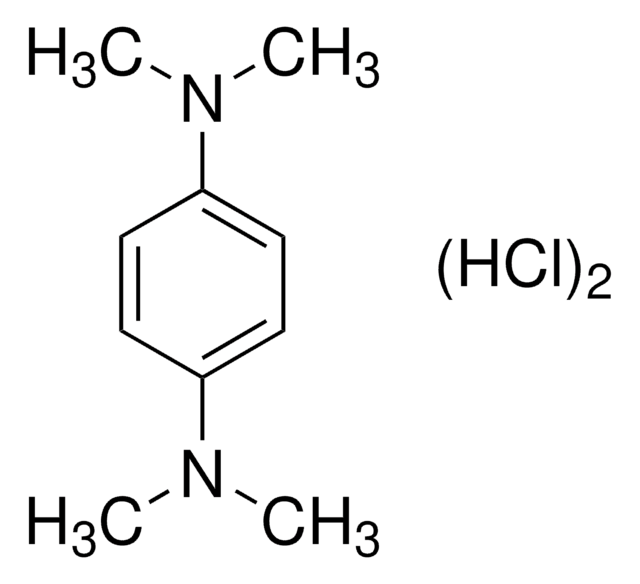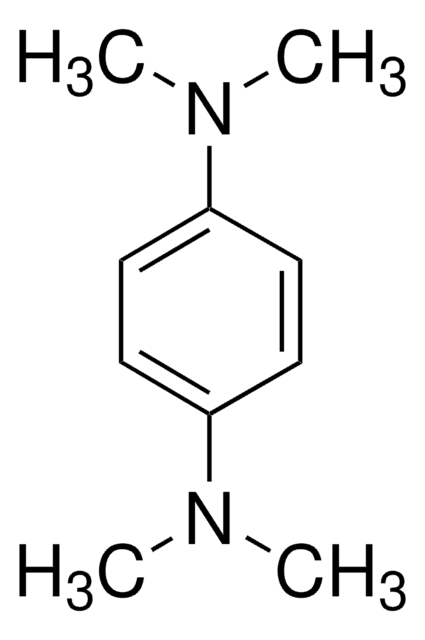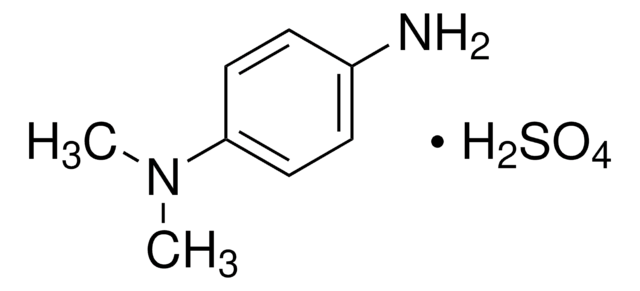07770
N,N-Dimethyl-p-phenylenediamine dihydrochloride
suitable for microbiology, ≥99.0%
Synonyme(s) :
4-Amino-N,N-dimethylaniline dihydrochloride, DMPD · 2HCl, DMPPDA · 2HCl
About This Item
Produits recommandés
Niveau de qualité
Essai
≥99.0% (AT)
≥99.0%
Forme
powder
Perte
≤0.05% loss on ignition
Pf
210-215 °C (dec.)
222 °C (dec.) (lit.)
Traces de cations
Ca: ≤10 mg/kg
Cd: ≤5 mg/kg
Co: ≤5 mg/kg
Cr: ≤5 mg/kg
Cu: ≤5 mg/kg
Fe: ≤5 mg/kg
K: ≤50 mg/kg
Mg: ≤5 mg/kg
Mn: ≤5 mg/kg
Na: ≤500 mg/kg
Ni: ≤5 mg/kg
Pb: ≤5 mg/kg
Zn: ≤5 mg/kg
Application(s)
food and beverages
microbiology
Chaîne SMILES
Cl[H].Cl[H].CN(C)c1ccc(N)cc1
InChI
1S/C8H12N2.2ClH/c1-10(2)8-5-3-7(9)4-6-8;;/h3-6H,9H2,1-2H3;2*1H
Clé InChI
IAEDWDXMFDKWFU-UHFFFAOYSA-N
Vous recherchez des produits similaires ? Visite Guide de comparaison des produits
Description générale
Application
Attention
Mention d'avertissement
Danger
Mentions de danger
Conseils de prudence
Classification des risques
Acute Tox. 3 Dermal - Acute Tox. 3 Inhalation - Acute Tox. 3 Oral
Code de la classe de stockage
6.1A - Combustible acute toxic Cat. 1 and 2 / very toxic hazardous materials
Classe de danger pour l'eau (WGK)
WGK 3
Équipement de protection individuelle
Eyeshields, Faceshields, Gloves, type P2 (EN 143) respirator cartridges
Faites votre choix parmi les versions les plus récentes :
Certificats d'analyse (COA)
Vous ne trouvez pas la bonne version ?
Si vous avez besoin d'une version particulière, vous pouvez rechercher un certificat spécifique par le numéro de lot.
Déjà en possession de ce produit ?
Retrouvez la documentation relative aux produits que vous avez récemment achetés dans la Bibliothèque de documents.
Les clients ont également consulté
Notre équipe de scientifiques dispose d'une expérience dans tous les secteurs de la recherche, notamment en sciences de la vie, science des matériaux, synthèse chimique, chromatographie, analyse et dans de nombreux autres domaines..
Contacter notre Service technique










